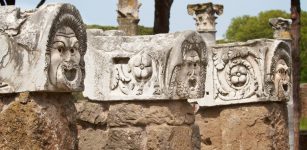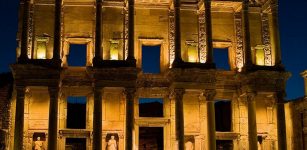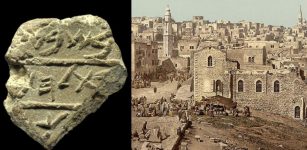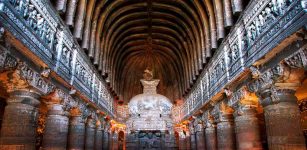Agni: Hindu God Of Divine Illumination And One Of The Three Supreme Deities Of Vedic Lore
A. Sutherland - AncientPages.com - Agni is the fire god, represented as red and two-faced (sometimes covered with butter), suggesting both his destructive and beneficent qualities and with black eyes and hair, three legs, and seven arms (rays).
Agni (right) with his son Skanda (Karttikeya), (dated to 1st-century AD.) Biswarup Ganguly - CC BY 3.0
Agni rides a ram or a chariot pulled by goats or, more rarely, parrots. Seven rays of light emanate from his body. One of his names is "Sapta jihva" (‘seven tongues'). He is worshipped under a triple form: fire on the earth, lightning, and the sun.
Agni, lord of the fire and power of heat and light, has its origin in Vedic lore and is one of the most important divinities in the Hindu pantheon.
It is said that in the Rig Veda, the earliest Sanskrit text, there are more hymns dedicated to Agni than to any other divinity. Agni is the demi-god ruling fire, (in Latin: ‘ignis’, which is the root of English, ignite).
Agni (also known as Agnideva), is sometimes considered to be the son of earth and sky and sometimes he is called the son of Angiras, a Vedic rishi (sage) of Hinduism and a teacher of divine knowledge, and also a messenger between men and gods.
In the system of five elements of nature, which is found in Vedas, there are Earth (bhumi), Water (jala), Air (Vayu), Space (aakash) and Fire (agni). Agni is the purest element since you can never try to contaminate Agni because when you touch Agni, he will turn you into ash.
Hindu priest performing Agni Pooja or Worship to Fire. Credit: Adobe Stock - korkorkusung
According to ancient Hindu beliefs, Agni dwelled in the two pieces of wood that could easily be transformed to fire when rubbed together. Therefore he represented a symbol of three powerful forces of nature – earthly fire, lightning, and sun.
Most popular among the fire gods, Agni was an important part of a home as the hearth fire, not only necessary for cooking food and heating water, but also served as the gathering place for the family.
He was considered a friend because his powers served people; he protected them, granted them wealth and length of life. Agni was called upon always to take the gods to the ritual place so that they can hear the praises of the chanters and their requests as well.
People have long celebrated the great god Agni (fire) during various festivals organized on a grand scale. One such beautiful festival of light is organized at Thiruvannamalai, Tamil Nadu.
However, Agni was not only associated with the hearth and earthly fire but also with sacrificial fire. It was later, he became much more as a purifier of sacrificial offerings rather than a fire god.
Agni on a ram. Credit: Public Domain
There is also yet another form of Agni, perhaps the most dangerous one. It is known as Vadavagni (literally Vadava-agni - “marefire”) and represents Agni’s most terrible form, which remains hidden deep under the sea. It’s waiting for the ‘right’ moment to destroy the world.
The Hindu scriptures mention an ancient belief that the escape of this fire from under the ocean which will, in the end, consume the current cycle of creation and prepare the universe for the next cycle of creation.
Later depictions of the god Agni show him in red or black color, with two faces, four hands, skin, which is red as fire flames, seven tongues for licking up the sacrificial butter, and a garland of fruit.
Another very interesting depiction of Agni shows him as Marut (immortal), one of the Hindu storm gods equipped with a flaming spear and riding in a chariot with wind instead of wheels and drawn with beautiful fiery horses.
Agni’s cult disappeared long ago but the ancient ceremonies associated with the fire still remain, keeping in mind the Hindu great deity – Agni, who grants immortality, purifies sinners after they died.
Also, participants of the funerals and wedding ceremonies never forget to call upon Agni.
Updated on June 21, 2021
Written by – A. Sutherland AncientPages.com Staff Writer
Copyright © AncientPages.com All rights reserved. This material may not be published, broadcast, rewritten or redistributed in whole or part without the express written permission of AncientPages.com
Expand for referencesMore From Ancient Pages
-
 Leonardo Da Vinci’s Mother Might Have Been A Slave – Here’s What The Discovery Reveals About Renaissance Europe
Featured Stories | Mar 30, 2023
Leonardo Da Vinci’s Mother Might Have Been A Slave – Here’s What The Discovery Reveals About Renaissance Europe
Featured Stories | Mar 30, 2023 -
 Problems With The Age Of Man And Theory Of Evolution – What Happened In The Past?
Ancient Mysteries | Oct 11, 2021
Problems With The Age Of Man And Theory Of Evolution – What Happened In The Past?
Ancient Mysteries | Oct 11, 2021 -
 Ostia Antica – Unique Ancient Harbor City In The Suburbs Of Rome
Civilizations | Nov 29, 2018
Ostia Antica – Unique Ancient Harbor City In The Suburbs Of Rome
Civilizations | Nov 29, 2018 -
 City Of Ephesus And Celsus Library With More Than 12,000 Scrolls
Featured Stories | Sep 17, 2015
City Of Ephesus And Celsus Library With More Than 12,000 Scrolls
Featured Stories | Sep 17, 2015 -
 Ancient Seal Found In The City Of David: Evidence Of Bethlehem’s Existence Long Before Jesus Was Born
Archaeology | May 24, 2012
Ancient Seal Found In The City Of David: Evidence Of Bethlehem’s Existence Long Before Jesus Was Born
Archaeology | May 24, 2012 -
 Mystery Of The Lost Arctic Civilization- Two Ancient Mummies Found At The Zeleny Yar Necropolis
Archaeology | Jul 20, 2017
Mystery Of The Lost Arctic Civilization- Two Ancient Mummies Found At The Zeleny Yar Necropolis
Archaeology | Jul 20, 2017 -
 Early Farmers On The Baltic Coast Incorporated Fish Into Their Diets 6,000 Years Ago
Archaeology | Oct 17, 2023
Early Farmers On The Baltic Coast Incorporated Fish Into Their Diets 6,000 Years Ago
Archaeology | Oct 17, 2023 -
 On This Day In History: Myles Coverdale Who Printed First English Bible Died – On Jan 20, 1569
News | Jan 20, 2017
On This Day In History: Myles Coverdale Who Printed First English Bible Died – On Jan 20, 1569
News | Jan 20, 2017 -
 New Method Reveals Falsified And Original Manuscripts Of Famous Robert Burns
Archaeology | Jul 28, 2018
New Method Reveals Falsified And Original Manuscripts Of Famous Robert Burns
Archaeology | Jul 28, 2018 -
 Ancient Nandivardhan Was The City Of Vakataka Rulers Who Built Ajanta Caves
Archaeology | Jun 13, 2018
Ancient Nandivardhan Was The City Of Vakataka Rulers Who Built Ajanta Caves
Archaeology | Jun 13, 2018 -
 Evidence Of Cosmic Catastrophe 12,800 Years Ago – Earth Collided With Fragments Of A Comet
Archaeology | Feb 2, 2018
Evidence Of Cosmic Catastrophe 12,800 Years Ago – Earth Collided With Fragments Of A Comet
Archaeology | Feb 2, 2018 -
 Enigma Of Ancient Upside Down Stairs At Sacsayhuamán
Ancient Mysteries | May 27, 2014
Enigma Of Ancient Upside Down Stairs At Sacsayhuamán
Ancient Mysteries | May 27, 2014 -
 Great Pyramid Puzzle: ‘Lost’ 5,000-Year-Old Piece Of ‘Dixon Relics’ Accidentally Found
Archaeology | Dec 17, 2020
Great Pyramid Puzzle: ‘Lost’ 5,000-Year-Old Piece Of ‘Dixon Relics’ Accidentally Found
Archaeology | Dec 17, 2020 -
 Mysterious Mummified Woman With A Christian Cross On Her Chest Dashes Hopes Of Finding First Russian Fortress In Yakutia
Archaeology | Dec 12, 2019
Mysterious Mummified Woman With A Christian Cross On Her Chest Dashes Hopes Of Finding First Russian Fortress In Yakutia
Archaeology | Dec 12, 2019 -
 Amazing Giant Rock Engravings Discovered In South America May Be The World’s Largest
Archaeology | Jun 5, 2024
Amazing Giant Rock Engravings Discovered In South America May Be The World’s Largest
Archaeology | Jun 5, 2024 -
 Which Came First: The Reptile Or The Egg?
Evolution | Jun 12, 2023
Which Came First: The Reptile Or The Egg?
Evolution | Jun 12, 2023 -
 Evidence Humans Walked The Great Plains 18,000 Years Ago May Have Been Found – Archaeologists Say
Archaeology | Mar 14, 2022
Evidence Humans Walked The Great Plains 18,000 Years Ago May Have Been Found – Archaeologists Say
Archaeology | Mar 14, 2022 -
 Viking Grave Discovered In The Middle Of Oslo, Norway
Archaeology | Dec 23, 2022
Viking Grave Discovered In The Middle Of Oslo, Norway
Archaeology | Dec 23, 2022 -
 Rene Descartes – Independent French Thinker And His Main Ideas
Featured Stories | Apr 27, 2021
Rene Descartes – Independent French Thinker And His Main Ideas
Featured Stories | Apr 27, 2021 -
 On This Day In History: Spanish Villasur Expedition Wiped Out By Pawnee And Otoe Warriors – On August 14, 1720
News | Aug 14, 2016
On This Day In History: Spanish Villasur Expedition Wiped Out By Pawnee And Otoe Warriors – On August 14, 1720
News | Aug 14, 2016



